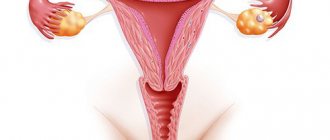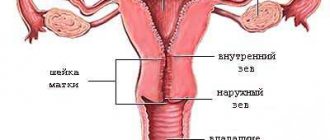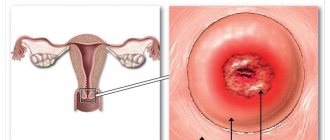Despite its relatively small size, the cervix is a rather complexly organized organ, and its pathology is very diverse. The inside of the cervical (cervical) canal is lined with cells of single-layer columnar epithelium. It has many depressions - glands that produce mucus, the properties of which vary depending on the age of the woman and the phase of the menstrual cycle. Outside (from the vagina), the cervix is covered with a completely different layer of cells—stratified squamous non-keratinizing epithelium. It moves to the vaginal vault and lines the vaginal cavity from the inside. It has no glands and changes less during the menstrual cycle. The border between these two types of epithelium is most often located in the area of the external uterine pharynx (entrance to the cervical canal of the uterus) and is called the transformation zone (Fig. 1).
Figure 1. Zonal anatomy of the cervix.
More than 90% of cervical neoplasia (precancerous condition) and cancerous lesions occur in the transformation zone.
Prices for services
Initial appointment with a gynecologist + ultrasound (assessment of complaints, medical history, examination in a gynecological chair, pelvic ultrasound, consultation)
Primary appointment – visiting a doctor of a specific specialty for the first time. Make an appointment
1800 ₽
Repeated appointment with the gynecologist
With the exception of repeated appointments with doctors: Blatsios N.D., Dzhashiashvili M.D. Make an appointment
1200 ₽
Ultrasound of the pelvis in women (uterine cavity, ovaries)
Make an appointment
1500 ₽
How it manifests itself
Most often, changes in the cervix do not manifest themselves in any way and are detected only during examination, which is why it is so important to undergo regular examinations by a gynecologist. But sometimes there may be:
- Pain and bleeding during sexual intercourse.
- Bloody discharge between periods.
- Bloody discharge during or after examination.
- Nagging pain in the lower abdomen.
- Discharge with a strong unpleasant odor
Such manifestations arise due to the fact that the epithelium of the cervical canal is more susceptible to irritants and is more easily injured.
These symptoms can also occur with other, more serious conditions. Therefore, when they appear, you should definitely contact a gynecologist for an examination, even if nothing else worries you.
Types of disease
The disease is:
- congenital – not considered an anomaly;
- acquired – diagnosed for progress
Based on the characteristics of the proliferation of columnar epithelium, the disease is classified into:
- glandular ectopia – characterized by an abundance of glandular structures;
- papillary (papillary) - the cylindrical epithelium is distinguished by the presence of a papule, with a vascular loop at the end;
- epithelizing (healing) - similar to the glandular one, however, the formation has healthy zones of normal flatness. No therapy is prescribed - the normal state is self-healing when the mature squamous epithelium completely replaces the columnar epithelium.
The appearance of cervical ectopia of the cervix makes it possible to establish the characteristics of the epithelial abnormality.
How to treat
True erosion goes away on its own after eliminating the cause. Therefore, in this case, you need to choose the right treatment regimen. If this is a consequence of an injury, then the erosion will heal without consequences. In case of infection, antibacterial therapy is necessary; in some cases, it is advisable to undergo a histological examination of the cervix and select therapy depending on its result.
The treatment regimen for ectopia will depend on the patient’s age, the size of the changes and the condition of the cervix, as well as on the results of the preliminary examination and the cause of the appearance. But most patients with ectopia only need to be monitored by a doctor.
Ectropion most often does not require treatment, however, with frequent inflammatory processes caused by this condition, a biopsy of the cervix and minimally invasive surgery aimed at restoring its structure makes sense.
Thus, in the vast majority of cases, changes in the cervix, which can be interpreted as erosion, are not such. Therefore, there is no need to carry out “cauterization” if the examination does not reveal indications for surgical treatment.
Methods of treating the disease
Treatment methods for ectopia are selected according to the characteristics of the disease. Both conservative and surgical treatment methods are used.
If there are no complications, and in case of a congenital anomaly, dynamic monitoring is carried out with annual examinations by a gynecologist, collection of an oncocytological smear and colposcopy.
In case of complications, therapy is developed taking into account the type of epithelial transformation and its causes. To treat an illness caused by an infection, antibacterial therapy is prescribed. For the treatment of hormonal disorders, the gynecologist will select appropriate medications.
Surgical treatments include:
- Diathermocoagulation (cauterization) – destruction of abnormal zones with special electrodes. Afterwards a crust remains, underneath it there is healthy epithelium. When the scab falls off, a scar remains. The procedure is suitable for women who do not plan to give birth;
- Laser coagulation - the laser destroys the columnar epithelium, leaving a thin film of tissue;
- Cryodestruction - abnormal columnar epithelium is removed with liquid nitrogen. A scab remains in place. Healthy tissues are minimally damaged;
- radio wave surgery – preserves tissue elasticity and does not leave scars.
The optimal method for destroying foci of the disease will be determined by the doctor.
What are Nabothian cysts (Ovula Nabothii)?
In the transformation zone, the flat epithelium gradually “creeps” onto the columnar epithelium, “closing” the ectopia. However, the excretory ducts of the glands may become closed, and the mucus they produce accumulates in the form of small cysts. These cysts can be multiple and range in size from 1 mm to 2 cm. Small cysts do not require any treatment. Only large (severely deforming the cervix) and continuing to grow cysts may require opening and evacuation of the contents. But this happens extremely rarely.
Diseases of the cervix include the following:
- Inflammation of the cervical canal (endocervicitis).
- Cicatricial post-traumatic (postpartum or postoperative) deformity.
- Human papillomavirus infection (HPV), including cervical condylomas.
- Cervical intraepithelial neoplasia (CIN) (Other names: dysplasia, dyskeratosis, squamous intraepithelial formation (SIL)) and cervical intraepithelial glandular neoplasia (CIGN).
- Cervical cancer: squamous cell carcinoma or adenocarcinoma.
- Endometriosis of the cervix.
- Polyps and fibroids of the cervical canal.
Read about diagnostic methods (colposcopy, targeted biopsy, cytological and histological studies) and treatment of precancerous diseases of the cervix (laser coagulation, cryodestruction, diathermoexcision, conization of the cervix) in the sections diagnostics, treatment and services.
- Inflammation of the cervical canal - endocervicitis . Most often it is caused by sexually transmitted infections (chlamydia, mycoplasma, gonococci) or nonspecific infections (streptococcus, staphylococcus, E. coli, corynebacteria, enterococcus, etc.). In the first case, infection occurs through sexual contact. The second group of microorganisms enters the cervix most often by lymphogenous (through lymphatic vessels) or contact (from the rectum) route; however, sexual intercourse is not necessary for their development, but can contribute to inflammation. Other provoking factors may be some benign diseases of the cervix (see below), cicatricial deformation of the cervix, weakening of general and local immunity. Endocervicitis is manifested by profuse mucous leucorrhoea, sometimes with an unpleasant odor. Endocervicitis can be one of the causes of miscarriage and premature birth. The disease can be suspected already during a gynecological examination: a large amount of mucus is released from the cervical canal, the transformation zone has a bright pink color. To diagnose the infection that caused the process, the following tests are taken: a smear for the degree of purity, culture for flora and sensitivity to antibiotics, testing for the presence of chlamydia, mycoplasma and ureaplasma (by PCR or culture), sometimes culture on special media to isolate trichomonas, fungus genus candida, gonococcus. Treatment for endocervicitis depends on what infection is causing it.
- Deformation of the cervix occurs due to traumatic childbirth or surgical interventions on the cervix. During labor, the cervix shortens, flattens, and then dilates to a diameter of 10 cm, allowing the fetal head to pass through the mother's birth canal. Sometimes, during the passage of the head, the cervix ruptures. This is facilitated by the following factors: rapid and rapid labor, weakness of labor with early ineffective pushing, inappropriate behavior of the woman in labor during pushing, which is often observed against the background of fatigue and painful contractions, the application of “high” obstetric forceps, a large fetus (weighing more than 4000 grams). ), previous operations on the cervix, including cervical excision, diathermocoagulation of ectopia, etc., ruptures in previous births. Most often, ruptures occur on the sides of the neck (at 3 and 9 o'clock). They can be of several degrees in depth. At the most severe degree, the ruptures reach the vaginal fornix and spread to the body of the uterus. After childbirth, the obstetrician examines the cervix “in the speculum” and, if ruptures are detected, closes them with absorbable sutures. Unfortunately, not all ruptures are diagnosed and carefully sutured. In such cases, the cervix after childbirth is formed defective - the cervical canal often remains gaping, and the cervix itself can take on the most bizarre shapes. If a woman is not planning a pregnancy, then nothing may bother her, and she will only find out about the presence of scars and deformities during the next gynecological examination. However, problems may arise during the next pregnancy - most often, spontaneous abortions (miscarriages) and premature births. There are extremely many reasons for spontaneous abortions, and cervical pathology is not the most common of them. However, cervical insufficiency can be suspected if the miscarriage occurs more than 16 weeks, begins with rupture of amniotic fluid, and there is a history of traumatic birth or cervical surgery. Diagnosis includes a visual examination in a gynecological chair, and, if necessary, cervicohysterography (X-ray examination with the introduction of a contrast agent into the lumen of the cervical canal and the uterine cavity). Treatment is required if a woman suffers from miscarriage due to severe deformation of the cervix. In such cases, surgical treatment is performed - cervical plastic surgery (tracheloplasty). If a cervical deformity is detected during pregnancy in the presence of signs of a threatening miscarriage, a special circular suture is placed on the cervix in order to preserve the pregnancy, designed to compensate for the lost mechanical function of the cervix. This suture usually remains until full term pregnancy. It is removed either on the eve of the expected birth, or in the event of the onset of labor.
- Papillomavirus infection (HPV) , including exophytic condylomas of the cervix.
 In short, you should know that: 1) the development of exophytic condylomas on the surface of the cervix, most often caused by papillomavirus type 6, leads to changes in the mucosa, which can be characterized as a mild degree of dysplasia (see point 4). 2) They themselves do not lead to the development of cancer and precancerous conditions of the cervix. 3) Small condylomas often undergo spontaneous regression (disappear on their own). 4) Oncogenic serotypes of HPV viruses (16, 18, 35, 39, 45) significantly increase the risk of developing severe dysplasia and cervical cancer. Moreover, they are the main cause of the development of these diseases. 5) Oncogenic types of viruses do not cause the development of exophytic condylomas. They are integrated into the genome of epithelial cells and change their genetic properties, promoting gradual cancerous degeneration. 6) Exophytic condylomas of large sizes, as a rule, must be removed (for example, using electrocoagulation, laser, podophyllotoxin preparations, etc.). 7) To date, there are no systemic medications that can reliably cure the papilloma virus. Detection of long-term persistence (preservation in the body) of oncogenic type papilloma viruses is the main risk factor for the development of severe degrees of dysplasia and cervical cancer, therefore, in this case, a particularly thorough and frequent examination of the cervix is required in order to detect the disease in time and adequately treat it.
In short, you should know that: 1) the development of exophytic condylomas on the surface of the cervix, most often caused by papillomavirus type 6, leads to changes in the mucosa, which can be characterized as a mild degree of dysplasia (see point 4). 2) They themselves do not lead to the development of cancer and precancerous conditions of the cervix. 3) Small condylomas often undergo spontaneous regression (disappear on their own). 4) Oncogenic serotypes of HPV viruses (16, 18, 35, 39, 45) significantly increase the risk of developing severe dysplasia and cervical cancer. Moreover, they are the main cause of the development of these diseases. 5) Oncogenic types of viruses do not cause the development of exophytic condylomas. They are integrated into the genome of epithelial cells and change their genetic properties, promoting gradual cancerous degeneration. 6) Exophytic condylomas of large sizes, as a rule, must be removed (for example, using electrocoagulation, laser, podophyllotoxin preparations, etc.). 7) To date, there are no systemic medications that can reliably cure the papilloma virus. Detection of long-term persistence (preservation in the body) of oncogenic type papilloma viruses is the main risk factor for the development of severe degrees of dysplasia and cervical cancer, therefore, in this case, a particularly thorough and frequent examination of the cervix is required in order to detect the disease in time and adequately treat it. - Cervical intraepithelial neoplasia (dysplasia) . This term (CIN) is used to refer to disorders of the maturation and structure of stratified squamous epithelium. Changes are assessed by cytological examination of cell scrapings from the surface of the neck and/or by histological examination of biopsy material. This pathology is associated with impaired cellular differentiation and maturation. There are three degrees of dysplasia: CIN I, CIN II, CIN III. With mild dysplasia (CIN I), cell maturation is impaired in the lower third of the epithelial layer. The top two thirds look typical. With the second and third degrees of dysplasia (CIN II, CIN III), cell maturation is impaired, respectively, in 2/3 or throughout the entire thickness of the epithelium. The next most severe cellular and tissue changes are carcinoma in situ, which translates as cancer “in place,” that is, within the epithelial layer, without growing into the underlying tissue of the cervix.
In turn, CIGN is an analogue of CIN, but refers to columnar epithelium. CIGN is judged by cellular atypia of the epithelial layer. Accordingly, adenocarcinoma in situ is distinguished as the most severe dysplasia. Cells of altered tissue (both squamous and cylindrical epithelium) look atypical, which is confirmed by cytological examination of scrapings from the surface of the cervix (Papanicolau smear). In them, the nucleus is enlarged, it has a lighter color, and the content of cytoplasm in the cell is reduced. In addition to the changes described, blood vessels also acquire a special structure: they come close to the surface, arranged in the form of loops, spirals and other elaborate shapes. This helps distinguish healthy tissue from pathological tissue during colposcopic examination of the cervix.
Cervical ectopia: treatment for nulliparous women
Based on the diagnostic results, the specialist may prescribe drug therapy or surgery.
Conservative treatment in nulliparous patients is carried out at home with the help of various drugs - antibiotics, anti-inflammatory drugs, hormonal therapy, local effects. Drugs and treatment features are individual.
To remove foci of the disease, radio wave surgery is most often prescribed, since it is as safe as possible for future pregnancy and childbirth.
Diagnostics
When viewed with the naked eye, ectopia has a bright red color, clear boundaries, and a granular surface. The shape and size of ectopia are different. It can be located around the external os, on the anterior or posterior lip of the cervix.
A more detailed picture is provided by a study of the cervix such as colposcopy, i.e. examination using a microscope, which allows you to magnify all changed and unchanged areas of the cervix seven times or more. Already during colposcopy it is possible to differentiate benign changes from those suspicious for malignancy.
An important place in the diagnosis of background, precancerous and cancerous processes of the cervix is occupied by the cytological method - taking a smear from the cervix with a special cytobrush. Taking a smear for atypical cells (AC) is a painless and safe procedure. It allows for dynamic monitoring of the lesion both before and after treatment. Cytological examination makes it possible to diagnose a malignant process at the very initial stage.
Prevention
There are no special methods of prevention. General recommendations:
- healthy lifestyle;
- good nutrition;
- refusal to frequently change partners;
- pregnancy planning;
- use of contraception;
- timely treatment of inflammatory and infectious diseases of the genitourinary system.
It is important to have preventive visits to the gynecologist once every six months.
Other articles by the author
- Polycystic or polycystic ovary syndrome
- Uterine cancer
- Pelvic pain syndrome
- Stress urinary incontinence
- Ectopic cervix
Negative effects of erosion
Despite the fact that erosions do not interfere with conception, they can affect the process of bearing a baby and cause some problems during pregnancy. Areas with damaged epithelium are places where it is much easier for infection to penetrate, which can negatively affect the development of the fetus.
In addition, they are considered weak points that can become an area of tissue rupture during a difficult birth (especially with a large fetus). It is because of these factors that most doctors recommend treating erosion at the stage of pregnancy planning.
Happy stories
Polina
Sep 30 2021
Many thanks to your clinic and especially to Diana Omarovna!! IVF I got pregnant on the first try, my son is already 5 years old!!! I'll come again!!!
Read the story
Anna
28 Sep. 2021
We would like to express our deep gratitude and low bow to everyone who works in this clinic and, of course, to our doctor Aslanbek Ruslanovich Torchinov! On
Read the story
Svetlana
11 Sep. 2021
We would like to express our gratitude to the Fertimed clinic and in particular to the doctor from God Efimova Maria Sergeevna, she is our guardian angel thanks to her professionalism
Read the story
Sadovskaya-Shmeleva Tatyana Viktorovna
15 Jul. 2021
On May 4, 2021, a baby weighing 3150 grams and height 50 cm was born. This happiness cannot be expressed in words. Especially when the path to it is very long and difficult.
Read the story
Dzagoev family
May 03, 2021
Now I want to write my own story of happy motherhood. I have 9 years of infertility behind me, 4 IVF attempts, 3 of them were unsuccessful! 1 attempt was
Read the story
Svetlana
23 Feb 2021
I would like to express my deep gratitude to Tatyana Evgenievna Samoilova! Thanks to her, I am a happy mother! Our acquaintance began back in 2010, when
Read the story
Grineva Gulnaz
19 Feb 2021
I would like to express my deep gratitude to the doctor from God, Anna Anatolyevna Smirnova! It is thanks to her that we have been happy parents for five years now.
Read the story
Olga
23 Jan 2021
Our boy’s life began in Fertimed. Exactly 5 years ago they gave us his first photo, in it he was 8 weeks and 1 day old. What about us, future parents?
Read the story
Oksana
23 Dec 2020
I would like to express my gratitude to the MOON AND BACK to Diana Omarovna, Margarita Beniaminovna, Mikhail Yuryevich for our son, whose birth we are almost
Read the story
Natalia
29 Nov. 2020
I am 40, my husband is 49. We have a male factor, which makes it very difficult to get pregnant: most embryos stop on the 5th day of development. Except
Read the story
Elena
13 Nov. 2020
Our Moscow holidays were spent at the Fertimed clinic to fulfill our deepest desires. After endless attempts to get pregnant with...
Read the story
Marina
Oct 11 2020
It is impossible to express in words all the gratitude to our wizard - Torchinov Aslanbek Ruslanovich!!! Thanks to him, our baby was born on March 29, 2020.
Read the story
Irina
12 2020
I would like to express my deep gratitude to all the employees of this center for their professionalism. I would like to say a special HUGE THANK YOU to our doctor
Read the story
Orlova Olga Aleksandrovna and Chemodurov Dmitry Leonidovich
24 Jul. 2020
We would like to express our deep gratitude to all the doctors at this clinic! Thanks to you, we have two wonderful children growing up in our family - Zakhar (24.0
Read the story
Oksana
29 Jun 2020
Hello! We have an unusual story. My husband and I had our first children born in EB. Because We always wanted a very large family, so we decided not to stop..
Read the story
Evgeniya
May 16, 2020
My children are already 11 and 8 years old, but I periodically remember you with gratitude, dear Fertimed. Especially Anna Anatolyevna, Diana Omarovna, Margar
Read the story
Irina
17 Apr 2020
We owe our happy story to Anna Anatolyevna Smirnova! Thanks to her professionalism, our son was born. Anna Anatolyevna - they will notice
Read the story
Nikolai and Ekaterina
19 Feb 2020
Dear FertiMed, my wife and I want to sincerely thank the wonderful doctor, smart woman and great professional - Anna Anatolyevna Smirnova and sk
Read the story
Maria
10 Dec. 2019
Two years of unsuccessfully visiting doctors with my husband. We were advised to contact Zhordanidze Diana Omarovna in Fertimed. Wonderful doctor! Rezul
Read the story
Alipat
Oct 21 2019
Thanks to you, your clinic and Anna Anatolyevna Smirnova, I came to my cherished dream after 7 years of wandering from one doctor to another. Thankfully, I found out about
Read the story
Natalia
09 Oct 2019
I'll write a story too. 7 years of infertility, 3 IVF attempts. Out of desperation, I go and ask for a referral for laparoscopy. And in the intensive care unit I got into a conversation with a woman. TO
Read the story
Natalia
20 Feb 2019
Hello. I want to express my deep gratitude to your center. I got the impression of a close-knit team focused on results. Were treated by
Read the story
Andrey and Alexandra
14 Feb 2019
Many thanks from our entire large family to all the employees of the center for your work, for the smile on your face and faith in a positive result! Mihai
Read the story
Valentina
15 Jan 2019
My husband and I’s path to the happiness of being parents began in 2012 after the sounds of Mendelssohn’s wedding march died down. Like everyone else, we thought
Read the story
Catherine
May 16, 2019
After marriage, I couldn’t get pregnant at the age of 22; it turned out to be problems with the fallopian tubes. When I found out that I could never have anything on my own
Read the story
Olga
02 Mar 2019
I would like to express my deep gratitude to the FertiMed clinic, and especially to doctor Aslanbek Ruslanovich, for his good, caring attitude, and also for his
Read the story
Irina
23 Jun 2018
I would like to express my deep gratitude to the wonderful doctor of the FertiMed clinic, Aslanbek Ruslanovich Torchinov, for our long-awaited son. On hold
Read the story
Yuri
May 15, 2018
It will probably be an unusual review, since this is a review from a new father, and in general, I don’t really understand how I can express ours to you,
Read the story
Catherine
15 Dec. 2017
We first turned to FertiMed back in 2010, after 3 years of visiting doctors and undergoing all sorts of exotic tests. Unfortunately, the first
Read the story
Catherine
25 Sep. 2017
I got married at 22, my husband was 23, I never thought that there might be problems with conception, it turned out after I had appendicitis in childhood.
Read the story
Elena
May 23, 2017
My husband and I dreamed of having a child for 6 years. I have an adult daughter (20 years old) from my first marriage; my husband had no children. Passed several attempts at Eco in p.
Read the story
Elena
21 Feb 2017
My husband and I wanted more than anything to become parents, but time passed, wandering around to different doctors led to nothing, constant tests and treatment
Read the story
Nina and Peter
27 Sep. 2017
My husband looked at his spermogram as if it were a death sentence - not a single sperm count. And the reason is unclear. There was only one hope - for TEZU. It was explained to us that
Read the story
Faith
18 Jul 2016
I was ready to do anything to have a baby. By the age of 32, I had already undergone five operations on my ovaries and only one tiny piece remained from them. Nasty
Read the story
Maria
27 Jun 2016
I had two ectopics and no chance of having my baby. The irony was that my closest
Read the story
Valentina and Mikhail
Oct 14 2016
My husband and I flew from Kamchatka. They really wanted a second child. FertiMed was recommended by friends. They say that small and thin women like me have
Read the story
Sophia
27 Jul 2016
At FertiMed, at first they didn’t believe that I had 43 IVF attempts. There was clearly distrust and sympathy in the eyes of the staff - they say the woman went crazy.
Read the story
Alya
30 Sep. 2016
When I left my husband, with whom we had three children, no one, of course, could understand this, and no one wanted to. And even more no one could understand what m
Read the story
Valentina and Victor
01 Nov 2016
Our Dasha is growing up, at 1 year and 9 months she is a very smart girl, learning the alphabet on her own tablet (a real one, not a toy one)
Read the story
Christina
05 Apr 2016
I was 45 when I was ready for IVF. At the first meeting, the doctor at FertiMed said: there is no chance of having a child with my own eggs. At first there were sh
Read the story
Yana
13 2016
I am 29 years younger than my husband. He has three adult children, but I really wanted my child and ours together. Over the past few years, my husband has been very
Read the story
Anna
01 Mar 2016
I'm a happy mom! 5 years of standing with a birch tree, measuring basal temperature, tracking ovulation, hysteroscopy, laparoscopy (for my husband too), clostil
Read the story
The main advantages of this method used in our center:
- speed of treatment
- painlessness
- bloodlessness
- does not cause scarring of the cervix
- minimal number of complications
- accelerated healing
Types of colposcopy
- Simple - without the use of medications, it has no particular clinical significance;
- Advanced - the use of various special tests to examine the mucous membrane of the cervix;
- 3% acetic acid - constricts unchanged blood vessels, the test is mandatory and has the greatest clinical significance;
- Schiller's test - a test with Lugol's solution (iodine reveals glycogen in the epithelium), the affected tissues are not stained;
- trichlortetrazole - detection of LDH as a cancer marker;
- adrenaline test - vascular.
Ectopic epithelium of the cervix is a serious disease that requires a comprehensive examination.






